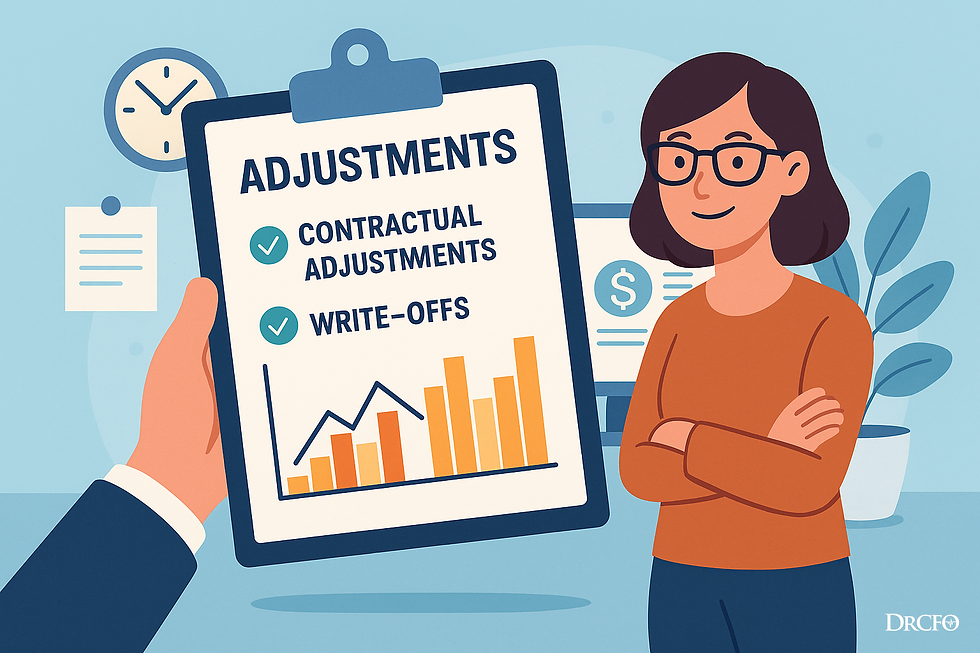The Doctor’s Debt Detox: Turning Liabilities into Leverage
- Doctors CFO
- Oct 27
- 2 min read
Debt in medicine often carries stigma. Many providers view it as a sign of overreach or mismanagement. In truth, debt itself is neutral—it’s the structure of that debt that determines whether it becomes a burden or a catalyst.
Smart financing doesn’t weaken a practice; it strengthens it—when guided by strategy and discipline. That’s the essence of a debt detox: not avoidance, but alignment.

1. Diagnosing Financial Health
Just as clinicians perform diagnostics before treatment, practice leaders should examine their balance sheet before prescribing financial cures.
Identify every liability—its interest rate, term, collateral, and payment frequency. Note which debts are productive (funding assets or revenue generation) versus reactive (covering short-term cash gaps).
Seeing the full picture transforms anxiety into strategy. When you understand where each dollar of debt lives and what it supports, you stop reacting to payments and start managing outcomes.
2. Consolidation as Treatment
A “debt detox” doesn’t mean eliminating obligations overnight—it means streamlining them.
Through consolidation, a practice merges multiple loans into one with a lower blended rate and defined repayment horizon. This simplified structure:
Reduces administrative time
Minimizes missed or late payments
Strengthens credit standing
It’s like converting a chaotic medication schedule into a single daily dose—simpler, safer, and more effective.
3. Side Effect: Predictability
Predictability is medicine for cash flow.
When debt service becomes stable, your practice can plan confidently—hiring new staff, investing in marketing, or upgrading equipment—without the stress of fluctuating outflows.
The same logic that keeps patient scheduling efficient applies to finance: consistency prevents chaos. Predictable payments give leadership breathing room and mental clarity.
4. Preventing Relapse
Consolidation is only sustainable with disciplined habits. Treat your financial systems like a patient requiring regular monitoring.
Reconcile books monthly
Maintain a 90-day rolling cash-flow forecast
Review interest rates and loan terms annually
These aren’t emergencies—they’re checkups. The healthiest practices make them part of their leadership rhythm, not reactive fire drills.
5. From Liability to Leverage
Debt becomes leverage when it funds productive assets—not when it covers deficits.
Used strategically, borrowed capital can finance:
New providers who expand patient capacity
Diagnostic tools that improve efficiency
Renovations or service expansions that increase revenue per square foot
When returns exceed borrowing costs, debt transforms from drag to thrust. The difference lies in intentionality: borrowing with a business case, not out of panic.
6. Mindset Shift
Think of your practice’s financial system as a patient chart. Your vital signs include:
Days in accounts receivable
Debt-service coverage ratio
Working capital ratio
Ignoring them doesn’t make problems disappear. Monitoring them—before symptoms worsen—ensures financial longevity.
Healthy practices don’t fear debt; they diagnose, treat, and manage it proactively.
7. The CFO Prescription
✅ Audit all loans and credit lines
✅ Model consolidation scenarios using conservative assumptions
✅ Implement automated payments to prevent delinquency
✅ Redirect freed cash into productive assets, not personal spending
✅ Review performance quarterly to ensure continued leverage efficiency
Debt isn’t poison; unmanaged debt is. With the right diagnosis and treatment plan, liabilities evolve into leverage—and leverage fuels growth.
Your balance sheet can be a burden, or it can be a launchpad. The choice is in the structure—and the strategy behind it.








Comments